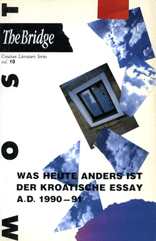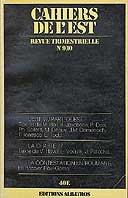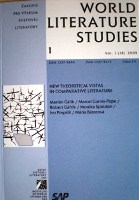
We kindly inform you that, as long as the subject affiliation of our 300.000+ articles is in progress, you might get unsufficient or no results on your third level or second level search. In this case, please broaden your search criteria.
















Reviewed Books: Anders Pettersson – Gunilla Linberg-Wada – Margareta Petersson – Stefan Helgesson: Literary History: Towards a Global Perspective. Berlin, New York: Walter de Gruyter, 2006; Comparative Literature in an Age of Globalization. Ed. Haun Saussy. Baltimore: The Johns Hopkins University Press, 2006; History of the Literary Cultures of East-Central Europe: Junctures and Disjunctures in the 19th and 20th Centuries. Volume I, II, III. Eds. Marcel Cornis-Pope and John Neubauer. John Benjamins Publishing Company. Amsterdam—Philadelphia 2004, 2006, 2007
More...
Dionyz Ďurišin (1929–1997) was one of the best Slovak literary theorists and a wellknown literary comparativist abroad. From the 1970s until his untimely death, he collaborated intensively with literary scholars from the former Czechoslovakia and from other countries of Central and Southern Europe. One of a small number of Slovak literary scholars at the beginning of the 1970s, with the publication of his Vergleichende Literaturforschung. Versuch eines methodisch-theoretischen Grundrisses1 and Sources and Systematics of Comparative Literature2, Ďurišin became one of the most important theorists of comparative literature amongst the members of the AILC/ICLA. His first book, translated into German in 1972, was originally entitled Problemy literarnej komparatistiky (Problems of Literary Comparison).3 Translations followed, from Slovak or Russian, into other languages, including Hungarian, Macedonian, and even Chinese and Japanese. An exception amongst scholars from Central, Eastern and Southern Europe, Ďurišin was a source of inspiration for scholars of interliterary research in the United States, Canada, Latin America, Germany, France, The Netherlands, Italy, Spain, Portugal, and even in India, China and Japan. It is a pity that the works of the last period of his life are still less well-known in the West and in Asia, but now it would seem a good time for international scholars to become familiar with them.
More...
Although the concept of identity is a strategic and positional concept, common sense tends to think of national identities as unproblematic categories, pointing to essential qualities in much the same way that natural objects do. Identities, however, are constructed by highly divergent discourses and practices. This situation calls for a contextual approach to identity building that will trace the historical contingency and the plurality of the symbolic processes that are cloaked in such constructions. Identity, maintains Stuart Hall, is constituted by the reiterative power of discourse to produce that which also names and regulates. It is a strategic and a positional category, ‘never singular but multiply constructed across different, often intersecting and antagonistic discourses, practices and positions’. (Hall, 4) At the very core of identity there is always an essential level that we might call ‘narrative identity’ (Randall, 54- 56), consisting of the stories we tell to ourselves about ourselves and the stories we or others tell to others, or stories that are told to others about ourselves – that is, all the stories in which we are included. In the following pages I shall focus on several aspects of identity building, seen as a discursive and an historical instance: the narrative devices that foster a range of both top-down and bottom-up processes of symbolic projection; the basic interaction between stimulus data and stored background knowledge in identity building; the relationships between self-identifications and stereotype representations of the Other; the crisscrossing of inside and outside literary projections, triggered off by identification.
More...
The notion of ‘world literature’ is inseparably related to comparative literature. However, the relationship between the two is ambiguous and explained in different ways. Indeed, an understanding of the first term demands a definition of comparative literature itself. Apart from Goethe’s understanding of the term world literature,2 a definition that started the debate, two views have gained general recognition. The first is the additive concept that views world literature as the sum of all (national, or individual) literatures of the world. The second view is a selective one that takes world literature to mean the world’s classics, or ‘peak works’ that are read across temporal, cultural and linguistic borders in which they were produced and become the universal heritage of humanity. The term world literature has a significant position in Slovak comparative literary studies, especially so in the work of Dionyz Ďurišin. The term was present in his writings from the beginnings of his involvement with comparative literature, but it was only from the mid-1980s that he made it one of the essential terms of his theory of interliterariness. The Slovak school of comparative literature studies formed in the 1940s, with Karol Rosenbaum, Milan Pišut, and Mikulaš Bakoš considered as its founders. Mikulaš Bakoš took over the project of historical poetics of the Russian literary scholar, Alexander Veselovskij, which demanded ‘the explanation of the essence of poetry from its history’. Veselovskij tried to come to a theory of literature by an examination of its history. In his opinion, literature can be better understood by history than by aesthetics. Mikulaš Bakoš enriched Veselovskij’s thoughts by examining period styles and genres in trying to understand the development of literature.
More...
In this paper I have in mind what art, especially literature, means for the modern person — whether and how literature can influence the direction and development of a human life, and thus in turn of humankind. Whether literature is something written by an author and then interpreted by the theorist; or whether the author is simultaneously writer and interpreter in one. The approach I take — one of permanent comparing and of looking to the context of individual items — is based on Ďurišin’s theory of typological and genetic comparison. I have dealt with the theory elsewhere and I have also developed aspects of it in relation to interdisciplinary analysis and studies of discourse. For a more comprehensive discussion, see the introductory chapter, ‘Kontextualisierung des literarischen Werkes’, of my monograph.2 My speculations follow the direction of A. Compagnon whose work draws on the research of the past two decades to do with the meaning of art and the notion of mimesis as recognition. Compagnon weaves threads from the works of Frey, Ricoeur and Ginzburg, whose convoluted theoretical questions are elaborated in the third chapter, ‘Svet’ (The World) of his book, Démon teórie (Literature, Theory, and Common Sense). In the earlier chapters Compagnon has tried to come to a definition of literature, focusing mainly on the subject of the author and his or her intention. Compagnon examines theories that have questioned or displaced the idea of authorial intention and that, putting aside the cultural, historical and social context of a work of literature, gave pre-eminence to the narrative value of the text itself. Compagnon distances himself from these theories, writing: ‘I would like to step out of the trap of this absurd alternative between objectivism/subjectivism and demonstrate that the only possible criterion for the validity of the interpretation is definitely the intention, which, however, cannot be identified with ‘the clear and prescient purpose’ (ibid., p. 84). Compagnon attempts to escape the objectivist/subjectivist dichotomy with an appeal to a more complex understanding of what art is and of the function of literature in society in his discussion of the most prominent theorists of the second half of the 20th century.
More...